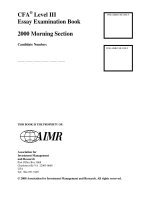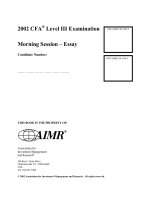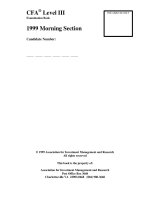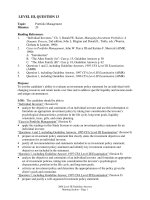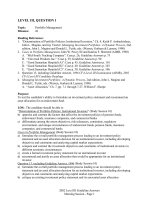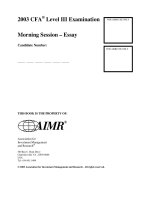L3 mock sample exam CFA level III guideline answers 2008
Bạn đang xem bản rút gọn của tài liệu. Xem và tải ngay bản đầy đủ của tài liệu tại đây (163.82 KB, 40 trang )
Level III
Question:
Topic:
Minutes:
1
Portfolio Management – Individual
36
Reading References:
15.
“Managing Individual Investor Portfolios,” Ch. 2 Managing Investment
Portfolios: A Dynamic Process, 3rd edition, James W. Bronson, Matthew H.
Scanlan, and Jan R. Squires (CFA Institute, 2007)
20.
“Goals-Based Investing: Integrating Traditional and Behavioral Finance,” Daniel
Nevins, Journal of Wealth Management (Institutional Investors, 2004)
Purpose:
Test individual portfolio management concepts.
LOS: 2008-III-4-15-j, k, l, n
15.
“Managing Individual Investor Portfolios”
The candidate should be able to:
j)
explain how to set risk and return objectives for individual investor
portfolios and discuss the impact that ability and willingness to take risk
have on risk tolerance;
k)
identify and explain each of the major constraint categories included in an
individual investor’s investment policy statement;
l)
formulate and justify an investment policy statement for an individual
investor;
n)
compare and contrast traditional deterministic versus Monte Carlo
approaches to retirement planning and explain the advantages of a Monte
Carlo approach.
LOS: 2008-III-4-20-c, d
20.
“Goals-Based Investing: Integrating Traditional and Behavioral Finance”
c)
justify the use of absolute performance and cash flow matching objectives
to meet the goal of lifestyle protection;
d)
compare lifestyle protection strategies with fixed horizon strategies and
explain when the use of each approach is appropriate.
2008 Level III Guideline Answers
Morning Session – Page 1 of 40
Level III
Question:
Topic:
Minutes:
1
Portfolio Management – Individual
36
Guideline Answer:
PART A
i.
The return objective for the Carvalhos’ portfolio is to:
- provide for the mortgage payments for a home
- support their living expenses in retirement
- maintain the inflation-adjusted value of the portfolio
ii.
CASH FLOWS
Current
Year 1
Inflows
Salary
Trust Distributions
Total Inflows
120,000
750,000
870,000
124,800
0
124,800
Outflows
Living Expenses
Down payment on home
Mortgage on home
Total Outflows
120,000
255,000
0
375,000
124,800
0
55,000
179,800
Net Inflows/(Outflows)
495,000
(55,000)
INVESTABLE ASSETS
Investable Assets
Current savings portfolio
Current year net inflow
Total Investable Assets
500,000
495,000
995,000
CALCULATION OF REQUIRED RETURN
Outflows required next year
Divided by investable assets
55,000
995,000
Plus expected inflation
Required After-Tax Nominal Return - arithmetic
Or
Required After Tax Nominal Return – geometric
=
5.53%
4.00%
9.53%
1.0553 x 1.0400 =
2008 Level III Guideline Answers
Morning Session – Page 2 of 40
9.75%
Level III
Question:
Topic:
Minutes:
1
Portfolio Management – Individual
36
PART B
Template for Question 1-B
i. Identify two factors in the Carvalhos’ situation that increase their ability to take risk.
- They have a long time horizon
- They are young and have more human capital
- They will receive another trust payout in 10 years
- They will potentially inherit a large sum of money from Mariana’s parents
- They have stable income
ii. Identify two factors in the Carvalhos’ situation that decrease their ability to take risk.
- They have a moderate asset base relative to required cash flows from the portfolio
- There is no assurance the children’s education will be covered by a scholarship and
the cost could be substantial
iii. Determine whether the Carvalhos have below-average, average, or above-average
ability to take risk.
(circle one)
Below-average
Average
2008 Level III Guideline Answers
Morning Session – Page 3 of 40
Above-average
Level III
Question:
Topic:
Minutes:
1
Portfolio Management – Individual
36
PART C
Template for Question 1-C
Constraint
i. Liquidity
ii. Time horizon
Prepare the following constraints of the Carvalhos’ IPS.
The Carvalhos need their investment portfolio to provide BRL55,000 for next
year’s mortgage payment.
The Carvalhos have a long-term multi-stage time horizon. In the short term,
they must pay living expenses and provide a home for their family. They
may also have to pay tuition for their children. Their second stage is
retirement, thirty years from now.
PART D
i.
The revised return objective for the Carvalhos’ portfolio is to:
- provide for the mortgage on their home
- support their living expenses in retirement
- support charitable endeavors in retirement
- provide a bequest for their children.
ii.
The after-tax nominal rate of return is 8.48%. The return is calculated using the following
inputs:
Mortgage payments remaining
Annual mortgage amount
Investment portfolio value (current)
Investment portfolio value (target)
5
BRL55,000
BRL10,200,000
BRL15,000,000
Using the HP12-C calculator, the following figures are used in the calculation when
solving for i:
N = 5, PV = 10,200,000, PMT = -55,000, FV = -15,000,000, compute i = 8.48%
or
N = 5, PV = -10,200,000, PMT = 55,000, FV = 15,000,000, compute i = 8.48%
Note: Salaries/expenses are a wash.
2008 Level III Guideline Answers
Morning Session – Page 4 of 40
Level III
Question:
Topic:
Minutes:
2
Portfolio Management – Individual/Behavioral
9
Reading References:
7. “Heuristic-Driven Bias: The First Theme,” Ch. 2, Beyond Greed and Fear: Understanding
Behavioral Finance and the Psychology of Investing, Hersh Shefrin (Oxford University
School Press, 2002)
8. “Frame Dependence: The Second Theme,” Ch. 3, Beyond Greed and Fear: Understanding
Behavioral Finance and the Psychology of Investing, Hersh Shefrin (Oxford University
School Press, 2002)
11. “Investment Decision Making in Defined Contribution Pension Plans,” Pensions, Alistair
Byrne, (Palgrave McMillan 2004)
13. “A Survey of Behavioral Finance,” Ch. 18, Handbook of the Economics of Finance Nicholas
Barberis and Richard Thaler (Elsevier Science B.V., 2003)
Purpose:
Test behavioral finance concepts for individual
LOS: 2008-III-3-7-a
7.
“Heuristic-Driven Bias: The First Theme”
The candidate should be able to:
a)
evaluate the impact of heuristic-driven biases on investment decision-making
including representativeness, overconfidence, anchoring-and-adjustment, and
aversion to ambiguity.
LOS: 2008-III-3-8-a, b
8.
“Frame Dependence: The Second Theme”
The candidate should be able to:
a)
explain how loss aversion can result in investors’ willingness to hold on to
deteriorating investment positions;
b)
evaluate the impacts that the emotional frames of self-control, regret
minimization, and money illusion have on investor behavior;
LOS: 2008-III-3-11-b
11.
“Investment Decision Making in Defined Contribution Pension Plans”
The candidate should be able to:
b)
evaluate the impacts of status quo bias, myopic loss aversion, 1/n diversification,
and the endorsement effect on DC plan participants’ investment decisions and the
risk profile of their investment plans.
2008 Level III Guideline Answers
Morning Session – Page 5 of 40
Level III
Question:
Topic:
Minutes:
2
Portfolio Management – Individual/Behavioral
9
Guideline Answer:
Template for Question 2
Select the behavioral
finance concept best
exhibited in each of
Donaldson’s three
Donaldson’s statement
statements.
Note: No behavioral
finance concept can be
used more than once.
(circle one)
“My father was a buyand-hold investor but I
am an active trader. To
keep trading costs low, I
use an online brokerage
firm. I have done well
investing in technology
companies because I
know the industry.”
“I am holding a large
position in Omega
Corporation with a large
unrealized loss.
Omega’s stock price
declined last year when
reported sales and
earnings failed to meet
analyst expectations. I
took advantage of the
decline to increase my
position. Omega sales
growth has continued to
slow over the last year,
but I believe the stock is
still a good investment.”
Naïve diversification
Overconfidence
Explain how the behavioral finance
concept you selected affects
Donaldson’s investment decision
making.
Donaldson knows the technology industry
and he considers himself an expert
investor. Overconfidence frequently leads
to excessive trading and
underperformance.
Representativeness
Regret avoidance
Self-control
Naïve diversification
Overconfidence
Representativeness
Regret
avoidance
Donaldson’s reluctance to sell his losing
position reflects both regret avoidance and
belief perseverance. To avoid the stress
associated with admitting a mistake, he
hopes the stock will recover. Despite new
information (slowing sales and lower than
expected sales and earnings), Donaldson
has held onto his beliefs. He has
increased his position rather than admit a
mistake by taking the loss.
Self-control
2008 Level III Guideline Answers
Morning Session – Page 6 of 40
Level III
Question:
Topic:
Minutes:
2
Portfolio Management – Individual/Behavioral
9
Template for Question 2 (continued)
Select the behavioral
finance concept best
exhibited in each of
Donaldson’s three
Donaldson’s statement
statements.
Note: No behavioral
finance concept can be
used more than once.
(circle one)
“I read a newspaper
article reporting that
commercial property
values in the city have
Naïve diversification
increased 14 percent
annually since 2000.
Overconfidence
According to the article,
the average commercial
Representativeness
property in the city sold
for $1.5 million last year.
This makes me very
Regret avoidance
happy because I just
purchased a piece of
commercial property last
Self-control
month. There is no doubt
that it will be a good
investment.”
Explain how the behavioral finance
concept you selected affects
Donaldson’s investment decision
making.
Donaldson may have bought late in the
cycle, but believes that commercial
property values will continue to increase.
Donaldson, by relying on the
representativeness heuristic, has become
overly optimistic about a past winner.
2008 Level III Guideline Answers
Morning Session – Page 7 of 40
Level III
Question:
Topic:
Minutes:
3
Portfolio Management – Institutional
36
Reading Reference:
21. “Managing Institutional Investor Portfolios,” Ch. 3, Managing Investment Portfolios: A
Dynamic Process, 3rd edition, R. Charles Tschampion, Laurence B. Siegel, Dean J. Takahashi,
and John L. Maginn (CFA Institute, 2007)
Purpose:
Test institutional portfolio management concepts
LOS: 2008-III-21-b, c, d, e, f
21.
“Managing Institutional Investor Portfolios”
The candidate should be able to:
b)
discuss investment objectives and constraints for defined-benefit plans;
c)
evaluate pension fund risk tolerance when risk is considered from the perspective
of the (1) plan surplus, (2) sponsor financial status and profitability, (3) sponsor
and pension fund common risk exposures, (4) plan features, and (5) workforce
characteristics;
d)
formulate an investment policy statement for a defined-benefit plan;
e)
evaluate the risk management considerations in investing pension plan assets;
f)
formulate an investment policy statement for a defined-contribution plan;
2008 Level III Guideline Answers
Morning Session – Page 8 of 40
Level III
Question:
Topic:
Minutes:
3
Portfolio Management – Institutional
36
Guideline Answer:
PART A
The most likely effect of a decrease in the discount rate to 6.5% from 7.0% would be to increase
the calculated present value of TEPP’s liabilities (i.e., projected benefit obligation or PBO).
PART B
The excess return target in 2008 will increase to 3.0 percent from 2.5 percent. This is because the
total return target, 9.5%, in 2008 will remain the same as in 2007, but the discount rate is reduced
to 6.5 percent from 7.0 percent. The excess return target for 2008 is calculated as follows.
2007 Discount Rate
Plus: 2007 Excess Return Target
2007 Total Return Objective
2008 Total Return Objective
Less: 2008 Discount Rate
2008 Excess Return Target
Arithmetic Approach
7.0%
+ 2.5%
9.5%
9.5%
–6.5%
3.0%
Geometric Approach
1.0700
× 1.0250
1.0968 – 1 = 9.68%
1.0968
÷ 1.0650
1.0298 – 1 = 2.98%
PART C
TEPP’s risk objective is to invest so as to minimize the probability that the market value of plan
assets will fall below 65% of PBO.
2008 Level III Guideline Answers
Morning Session – Page 9 of 40
Level III
Question:
Topic:
Minutes:
3
Portfolio Management – Institutional
36
PART D
Template for Question 3-D
Attribute
Determine whether
each of the four
attributes indicates
TEPP’s ability to
take risk is above
or below the
airline industry
average.
(circle one)
Above
i. sponsor financial
condition
Justify each determination based on one
comparison between TEPP and the airline
industry related to the attribute.
Note: Consider each attribute independently.
•
•
Below
•
Above
ii. plan funding
status
•
Below
•
Above
iii. plan provisions
Below
•
Titan’s debt/asset ratio of .48 is higher than
the industry average of .39.
Titan’s operating loss margin of (7.63%) is
below the industry average loss margin of
(4.01%);
TEPP’s funding level of 70% of PBO is
less than the airline industry average.
TEPP anticipates sponsor contributions of
only 90% of the payments to beneficiaries,
which is less than average for the airline
industry.
Titan employees over age 50 are allowed to
retire early, while most airline industry
employees are not allowed to retire early.
The early retirement feature increases the
present value of TEPP’s benefit payments
compared to the airline industry.
Titan’s retiring participants have the option
to receive up to 50% of their benefit in a
lump sum, while most airline industry
employees do not have this option. The
lump-sum option increases the present
value of TEPP’s benefit payments
compared to the airline industry.
2008 Level III Guideline Answers
Morning Session – Page 10 of 40
Level III
Question:
Topic:
Minutes:
3
Portfolio Management – Institutional
36
•
Above
iv. participant
characteristics
•
Below
At 47, the average age of TEPP participants
is older than the airline industry average,
resulting in a shorter duration for TEPP’s
liabilities than that of the airline industry.
At 30%, the proportion of retired lives in
TEPP is above the airline industry average,
resulting in a shorter duration for TEPP’s
liabilities than that of the airline industry.
PART E
Liquidity requirements for TEPP are determined by the expected net cash outflow of the plan
defined as the difference between payments to beneficiaries and contributions received from
Titan. Titan’s planned contribution in 2008 of $927 million falls short of anticipated benefits
payments of $1,030 million. As a result, TEPP expects a net cash outflow in 2008. Assuming
that expected contributions and benefits are realized, TEPP will have a liquidity requirement in
2008 of $103 million, ($1,030 - $927).
PART F
i. Benefit payment obligations in the retired-lives pool are exposed to less inflation risk because,
unlike the active-lives pool, payments are fixed in nominal terms and do not adjust for
inflation. Benefit payment obligations in the active-lives pool are exposed to more inflation
risk than in the retired-lives pool because, unlike the retired-lives pool, active Titan employees
accrue pension benefits based on salary increases, which include inflation as a component.
ii. Liabilities in the active-lives pool will have a relatively longer average duration than liabilities
in the retired lives pool, reflecting the time remaining before active employees retire. Active
employees tend to be younger than retired employees. The age difference is indicated by the
fact that the minimum retirement age is 50 and that 30% of all TEPP participants are retired.
PART G
Barrows is incorrect. Titan’s risk management committee indicated that an asset-liability
management (ALM) objective to maintain the market value of pension assets at or above 65% of
PBO. From an ALM perspective, pension investments should be managed relative to pension
liabilities and not to external index benchmarks. The ALM goal is to limit the volatility of the
shortfall, but large holdings in stocks will increase the volatility of the shortfall because changes
in equity values will not correlate closely to changes in the value of plan liabilities. The shortfall
stands presently at 30% of liabilities. A downward move in stock prices occurring while Titan
remains unable to fully fund the plan would worsen the shortfall.
Tate is incorrect. The mismatch between short-term, risk-free securities and the 14-year duration
of Titan’s pension benefit obligation implies that changes in asset values will not correlate
2008 Level III Guideline Answers
Morning Session – Page 11 of 40
Level III
Question:
Topic:
Minutes:
3
Portfolio Management – Institutional
36
closely to changes in the value of plan liabilities, adding to the volatility of the funding shortfall.
Moreover, short-term, risk free assets would not be expected to earn a rate of return equal to the
actuarial discount rate during a period in which a normal, upward-sloping yield curve prevails,
causing the shortfall to worsen.
2008 Level III Guideline Answers
Morning Session – Page 12 of 40
Level III
Question:
Topic:
Minutes:
4
Portfolio Management – Asset Allocation
17
Reading References:
25.
“Asset Allocation,” Ch. 5, Managing Investment Portfolios: A Dynamic Process, 3rd
edition, William F. Sharpe, Peng Chen, Jerald E. Pinto, and Dennis W. McLeavey (CFA
Institute, 2007)
26.
“Linking Pension Liabilities to Assets,” Aaron Meder and Renato Staub (UBS Global
Asset Management, 2006)
Purpose:
To test knowledge and use of asset allocation
LOS: 2008-III-07-25-d, e, f, m
25.
“Asset Allocation”
The candidate should be able to:
d) contrast the asset-only and asset/liability management (ALM) approaches to asset
allocation;
e) explain the advantage of dynamic over static asset allocation and evaluate the tradeoffs of complexity and cost;
f)
evaluate return and risk objectives in relation to strategic asset allocation;
m) formulate and justify a strategic asset allocation, given an investment policy
statement and capital market expectations;
LOS: 2008-III-07-26-a, b, c
26.
“Linking Pension Liabilities to Assets”
The candidate should be able to:
a) contrast the assumptions concerning pension liability risk in asset-only and liabilityrelative approaches to asset allocation;
b) discuss the fundamental and economic exposures of pension liabilities and identify
asset types that mimic these liability exposures;
c) compare pension portfolios built from a traditional asset-only perspective to
portfolios designed relative to liabilities and discuss why corporations may
choose not to fully implement the liability mimicking portfolio.
2008 Level III Guideline Answers
Morning Session – Page 13 of 40
Level III
Question:
Topic:
Minutes:
4
Portfolio Management – Asset Allocation
17
Guideline Answer:
PART A
i.
Given Thurlow’s return requirement of 9.4%, corner portfolios #3 and #4 are the two
most appropriate portfolios to combine.
In addition to achieving the return requirement, the combination of portfolios #3 and #4:
1. is consistent with Thurlow’s risk tolerance of a maximum portfolio standard deviation
of 10%,
2. lies on the efficient frontier, and
3. will result in the highest Sharpe ratio among the all portfolio combinations that meet
Thurlow’s return requirement. [Sharpe ratio = (.25 x .46) + (.75 x .51) = .4975]
ii.
Based on the return requirement of 9.4%, the optimal weights of Portfolio 3 and Portfolio
4 is given by:
Required Return = (Return on Portfolio 3) x (percentage of overall portfolio
invested in Portfolio 3) + (Return on Portfolio 4) x (1 - percentage of overall
portfolio invested in Portfolio 3)
9.4% = 10.3% x w + 9.1% (1-w)
Solving for w = .25
Where: w = percentage of overall portfolio invested in Portfolio 3
Therefore, the optimal weighting of Portfolio 3 equals 25% and the optimal weighting for
Portfolio 4 equals 75%.
The weight of total equities in the portfolio = weight of US equities + weight of non-US
equities.
The weight of US equities = (the weight of portfolio 3) x (the allocation to US
equities in portfolio 3) + (the weight of portfolio 4) x (the allocation to US
equities in portfolio 4)
The weight of US equities = .25(74.1%) + .75(33.7%) = 43.8%
The weight of non-US equities = (the weight of portfolio 3) x (the allocation to
non-US equities in portfolio 3) + (the weight of portfolio 4) x (the allocation to
non-US equities in portfolio 4)
The weight of non-US equities = .25(4.0%) + .75(12.0%) = 10.0%
Therefore, the weight of total equities = 43.8% + 10.0% = 53.8%.
2008 Level III Guideline Answers
Morning Session – Page 14 of 40
Level III
Question:
Topic:
Minutes:
4
Portfolio Management – Asset Allocation
17
PART B
i.
The most appropriate asset allocation is 106.5% of investable funds to Corner portfolio 4
while borrowing 6.5% of investable funds at the risk-free rate.
Thurlow’s return requirement is 9.4%. Therefore the optimal allocation to Portfolio 4 is
determined as:
Required Return = (Return on Portfolio 4) x (percentage of overall portfolio
invested in Portfolio 4) + (Risk-free rate) x (1 - percentage of overall portfolio
invested in Portfolio 4)
9.4% = 9.1% (w) + 4.5% (1-w)
Solving for w = 1.065 = weight of portfolio 4
Where:
Expected return on Portfolio 4 = 9.1%
Expected risk-free rate = 4.5%
w = optimal allocation to Portfolio 4
The optimal asset allocation for the overall portfolio is:
Asset Class
US Equities
Non-US Equities
Long-term bonds
Real Estate
Risk free asset
1.065 x 33.7
1.065 x 12.0
1.065 x 36.7
1.065 x 17.6
1.0 – 1.065
Weight
35.9%
12.8%
39.1%
18.7%
-6.5%
ii.
By combining the tangency portfolio with the risk-free security, the expected riskadjusted return (Sharpe ratio) will improve from .49 to .51. This Sharpe Ratio for this
combination is higher than any other portfolio solution that meets the 9.4% return
requirement. The standard deviation of this portfolio is (approximately) 9.69%. This
standard deviation is lower than the 10% standard deviation of the optimal portfolio (the
optimal combination of portfolio 3 and portfolio 4 with no leverage).
iii.
The weight of total equities in the portfolio equals 48.7% = weight of US equities +
weight of Non- US equities = 35.9% + 12.8% = 48.7%
PART C
i.
The advantages of the resampled efficient frontier approach relative to the mean-variance
efficient frontier approach are:
2008 Level III Guideline Answers
Morning Session – Page 15 of 40
Level III
Question:
Topic:
Minutes:
4
Portfolio Management – Asset Allocation
17
1. the optimal portfolios resulting from the re-sampling process are more diversified;
2. the optimal portfolio weights from the re-sampled portfolios are more stable through
time.
ii.
Asset Liability Management (ALM) is preferred because:
1. ALM reduces risk by explicitly considering the liability exposures of the pension
plan.
2. The Asset Only approach can result in inefficient investment policies that may expose
the plan to excessive and unrewarded risk relative to liabilities.
3. ALM approaches typically result in an optimal portfolio with a higher fixed income
allocation.
2008 Level III Guideline Answers
Morning Session – Page 16 of 40
Level III
Question:
Topic:
Minutes:
5
Portfolio Management – Fixed Income Investments
13
Reading References:
27.
28.
30.
“Fixed-Income Portfolio Management-Part I,” Ch. 6, sections 1-4 (pages 1-40) Managing
Investment Portfolios: A Dynamic Process, 3rd edition, H. Gifford Fong and Larry D.
Guin (CFA Institute, 2007)
“Relative-Value Methodologies for Global Credit Bond Portfolio Management,” Ch. 5,
Jack Malvey, Fixed Income Readings for the Chartered Financial Analyst® Program, 2nd
edition, Frank J. Fabozzi, editor (CFA Institute, 2005)
“Hedging Mortgage Securities to Capture Relative Value,” Ch. 8, Kenneth B. Dunn,
Roberto M. Sella, and Frank J. Fabozzi, Fixed Income Readings for the Chartered
Financial Analyst® Program, 2nd edition, Frank J. Fabozzi, editor (CFA Institute, 2005)
Purpose:
To test fixed income portfolio management strategies.
LOS: 2008-III-8-27-h
27.
“Fixed Income Portfolio Management-Part I”
The candidate should be able to:
a.
explain the importance of spread duration;
LOS: 2008-III-28-d, e
28.
“Relative-Value Methodologies for Global Credit Bond Portfolio Management”
The candidate should be able to:
d)
discuss the primary reasons for secondary market trading, including yield/spread
pickup trades, credit-upside trades, credit-defense trades, new issue swaps, sectorrotation trades, yield curve-adjustment trades, structure trades, and cash flow
reinvestment;
e)
discuss and evaluate corporate bond portfolio strategies that are based on relative
value, including total return analysis, primary market analysis, liquidity and
trading analysis, secondary trading rationales and trading constraints, spread
analysis, structure analysis, credit curve analysis, credit analysis, and asset
allocation/sector analysis.
2008 Level III Guideline Answers
Morning Session – Page 17 of 40
Level III
Question:
Topic:
Minutes:
5
Portfolio Management – Fixed Income Investments
13
LOS: 2008-III-9-30-a, b, d
30.
“Hedging Mortgage Securities to Capture Relative Value”
The candidate should be able to:
a)
demonstrate how a mortgage security’s negative convexity will affect the
performance of a hedge;
b)
explain the risks associated with investing in mortgage securities and discuss
whether these risks can be effectively hedged;
d)
compare and contrast duration-based approaches versus interest rate sensitivity
approaches to hedging mortgage securities;
2008 Level III Guideline Answers
Morning Session – Page 18 of 40
Level III
Question:
Topic:
Minutes:
5
Portfolio Management – Fixed Income Investments
13
Guideline Answer:
PART A
Template for Question 5-A
Note: Ignore transaction costs.
Trade
1. Buy 7-year Ba2/BB
industrial corporate bonds;
Sell 7-year Baa3/BBB
industrial corporate bonds.
2. Buy 5-year callable
corporate bonds; Sell 5year non-callable
corporate bonds of the
same issuer.
3. Buy 7-year high coupon
mortgage pass-through
bonds; Sell 7-year low
coupon mortgage passthrough bonds.
Determine the
expected effect on the
portfolio’s value over
the next two weeks
for each potential
trade, given the
strategist’s market
expectations.
(circle one)
Positive
Negative
Positive
Justify each expectation with one
reason.
Lower quality corporate bond spreads
widen more than higher quality bond
spreads in a weak economic
environment due to a higher risk of
default.
The negative convexity of callable
bonds limits the price appreciation
relative to non-callable bonds in a
falling rate environment.
Negative
Positive
Negative
Higher coupon, mortgage pass-through
bonds will experience higher level of
prepayments and will have to be
reinvested into lower interest bearing
securities when interest rates decline.
2008 Level III Guideline Answers
Morning Session – Page 19 of 40
Level III
Question:
Topic:
Minutes:
5
Portfolio Management – Fixed Income Investments
13
PART B
Sector rotation occurs when an investment manager shifts the portfolio from a sector that
is expected to underperform to one that is expected to outperform. Sector rotation trading
strategies do not perform well in the corporate bond market, as compared to the equity
market, because the corporate bond market generally has less liquidity than the equity
market and higher trading costs than the equity market.
2008 Level III Guideline Answers
Morning Session – Page 20 of 40
Level III
Question:
Topic:
Minutes:
6
Portfolio Management – Alternative Investments
11
Reading References:
34.
“Alternative Investments Portfolio Management,” Ch. 9, Managing Investment
Portfolios: A Dynamic Process, 3rd edition, Jot K. Yau, Thomas Schneeweis,
Thomas R. Robinson, and Lisa R. Weiss (CFA Institute, 2007)
36.
“Commodity Forwards and Futures,” Ch. 6, Derivatives Markets, 2nd edition,
Robert L. McDonald (Addison Wesley, 2006)
Purpose:
To test knowledge and use of alternative assets
LOS: 2008-III-11-34-n
34.
“Alternative Investments Portfolio Management”
The candidate should be able to:
n) explain the three components of return for a commodity futures contract and
the effect that an upward- or downward-sloping term structure of futures
prices will have on roll yield;
LOS: 2008-III-11-36-1-a, b, c
36.
“Commodity Forwards and Futures”
The candidate should be able to:
a) discuss the unique pricing factors for commodity forwards and futures,
including storability, storage costs, production, and demand, and their
influence on lease rates and the forward curve;
b) identify and explain the arbitrage situations which arise as a result of the
convenience yield of a commodity and commodity spreads;
c) compare and contrast the basis risk of commodity futures with that of
financial futures.
2008 Level III Guideline Answers
Morning Session – Page 21 of 40
Level III
Question:
Topic:
Minutes:
6
Portfolio Management – Alternative Investments
11
Guideline Answer:
PART A
To implement the reverse cash-and-carry arbitrage, Dalk will need to short copper in the
spot market and establish a long synthetic position in the copper forward market. The
long synthetic commodity position consists of:
• a long position in the forward contract that expires in three months, and
• Zero-coupon bonds with a maturity date identical to the forward expiration date,
and a face value equal to the forward price at maturity.
PART B
The reverse cash-and-carry arbitrage involves the following transactions:
1. Go long the forward contract. There is no cost associated with the purchase of the
contract, but a payment of 313 cents/lb in three months is required.
2. Short the spot copper contract. This generates 316 cents/lb now. The short
position must be covered in three months, at the maturity of the forward contract.
Given a lease rate of 6% and a contract maturity of 3 months, a lease payment of
4.78 cents/lb (316e(.06)(3/12) - 316) is due at maturity.
3. Lend the proceeds of short sale. The proceeds of the short sale (316 cents/lb) can
be invested (loaned) for three months at a yield of 5%. At maturity, the proceeds
of loan is will be 319.97 cents/lb (316e(.05)(3/12)).
The profit associated with the reverse cash-and-carry arbitrage is 2.19 cents/lb.
Reverse cash-and-carry arbitrage
Cash Flows
Transaction
Time 0
Time T = 3/12
Long forward
0
-313 cents/lb
Short sell copper @ lease rate = 6%
316 cents/lb
Pay lease rate
-4.78 cents/lb
Lend short-sale proceeds @ 5%
-316 cents/lb
319.97 cents/lb
0
2.19 cents/lb
Total
PART C
The no-arbitrage price range for the forward price is:
S0 e(r+λ-c)T ≤ F0,T ≤ S0 e(r+λ)T.
2008 Level III Guideline Answers
Morning Session – Page 22 of 40
Level III
Question:
Topic:
Minutes:
6
Portfolio Management – Alternative Investments
11
Where:
S0 - spot price of the asset
r – the continuously compounded interest rate
T – time until expiration of the forward contract
F0,T – today’s price of forward contract that matures at T
λ – storage cost
c – convenience yield
The convenience yield is the benefit from physical ownership. The convenience yield
affects the no-arbitrage range for the forward price through the cost of short selling. An
arbitrageur who wants to short spot copper would need to compensate the lender of
copper for the loss of the convenience yield. Thus, a higher convenience yield will
increase the cost of shorting spot copper and decrease the lower bound of the no-arbitrage
range for the forward contract. The upper bound is unaffected, resulting in a wider noarbitrage price range.
2008 Level III Guideline Answers
Morning Session – Page 23 of 40
Level III
Question:
Topic:
Minutes:
7
Portfolio Management – Risk Management
17
Reading Reference:
37.
“Risk Management” Ch. 9, Managing Investment Portfolios: A Dynamic Process,
3rd edition, Don M. Chance, Kenneth Grant, and John Marsland, (CFA Institute,
2007)
Purpose:
To test principles of risk management
LOS: 2008-III-SS#-37-b, h, i
37.
“Risk Management”
The candidate should be able to:
b)
recommend and justify the risk exposures an analyst should report as part of an
enterprise risk management system;
h)
compare and contrast alternative types of stress testing and discuss the advantages
and disadvantages of each;
i)
evaluate the credit risk of an investment position, including forward contract,
swap, and option positions;
2008 Level III Guideline Answers
Morning Session – Page 24 of 40
Level III
Question:
Topic:
Minutes:
7
Portfolio Management – Risk Management
17
Guideline Answer:
PART A
Template for Question 7-A
Describe one source of each of the following risks facing RR.
Risk
i. Liquidity risk
Note: A single source may not be used for both liquidity
and settlement risk.
RR has recently made an acquisition through a relatively large shortterm syndicated loan. If RR faces difficulty in raising funds to pay
back the short-term syndicated loan at maturity, RR may be forced to
sell securities from its investment portfolio on short notice, and at
unfavorable prices.
RR invests in OTC derivatives. RR could be required to liquidate
positions prior to expiration at unfavorable prices.
ii. Settlement risk
RR invests in OTC derivatives that involve settlement through the
execution of bilateral agreements. The risk is that one party could be in
the process of paying the counterparty while the counterparty is
declaring bankruptcy.
In the case of currency swaps, settlement risk is increased because the
contracts often require the exchange of principal in addition to interest
payments.
2008 Level III Guideline Answers
Morning Session – Page 25 of 40

